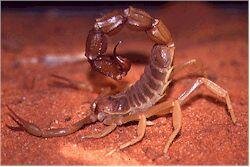Home > Don't just hike > Three SSS
The world at your feet ...
Scorpions
The scorpion figures among the signs of the zodiac. Defied by fear, he is a constellation in the sky. The scorpion is an Arachnid of the order Scorpions and in African the two main families are the Scorpionidae and the Buthidae. The former has large pedipalps (?‘pincers?’) and a slender tail bearing a small sting, and the latter slender pedipalps and a thick tail with a big sting.
The tail, which is part of the animal?’s abdomen, is a series of five prismatic segments and ends in a sixth joint, which is smooth and vesicular. This is where the venom is elaborated and held in reserve. The venom is an extremely complex fluid, made up of enzymes and proteins, and in the ?‘spitting scorpions?’ (Parabuthus Villosus) is considerably more potent than that of a cobra.
The dangerous species are almost entirely to be found in arid regions such as the Namib Desert. Those encountered in the Magaliesberg, while deserving respect, are not dangerous. As the sting curves sharply downward when the tail is upward, the scorpion is rarely in a physical position to sting a human being.
In both families, there are arboreal and rock dwelling species, one of which lives under the bark of trees and the other in cracks in rocks and are extremely tenacious of their dwellings.
The scorpion is frugal in his eating. Scorpions are solitary, but tend to live in colonies, each one separate. In the mating season they emerge at night, the swain selects his partner and engages with her in a dance. All this is leisurely and may include a stately form of jitter-bugging, both standing on their chests with tails straight in the air, stroking one another?’s tail. Eventually the male leads the female into a burrow. The dance is the mating, the male maneuvering his partner into position over the spermatophore he has deposited. The following morning the female devours the male.
The egg of the scorpion has little yolk. The embryo, at first, develops with the ventral surface curved round the beginnings of the appendages. It then reverses so that the dorsal side is uppermost, this is usual with arachnida. Now comes the extraordinary development. No yolk remains in the egg and the embryo is nourished directly from the mother?’s haemolymph. Even more remarkable is that this nourishment is sucked in through a chitinised teat in the ovarian duct thrust into the mouth of the developing creature. The young are born leisurely, two or three at once up to a number of about thirty, wrapped in a gossamer-thin membrane, enclosing a drop of pellucid fluid. The mother assists in unwrapping the infant, who then climbs onto the mother?’s back, being joined by others of the brood until all are accommodated. Mother and children fast motionless for a week, when the excoriation of a thin outer covering, not a true moult, takes place in the infants. They are now perfect scorpions, treble the volume they were at birth. For another week they remain with mother, nimble and full of energy climbing up and down, swinging from her tail. If they stray too far, she gathers them together with a sweep of her claws. Beware, little friend, maternal instinct will not stop her from regarding you as a tasty morsel if you are slow! During this time they do not eat, but share the mysterious ability to produce energy in the absence of food ?– miniaturized accumulators absorbing without mediation the rays of life?’s source ?– the sun. Now the tiny animal is ready to face the world. He finds a little burrow and waits, Scorpions do not chase their prey (preferably spiders or soft beetles) but wait till a suitable dish comes within reach of the ?‘pincers?’, grab it, and if it struggles strike it with the poisoned dart and leisurely eat it.
There are about six known families of scorpions, differences being minor. With his ancient pedigree, he must be considered a highly successful animal, a miracle of design and precision engineering, daintily decorated with delicate tooling here and there. The chemistry and physiology are stable. Occasionally a specimen with tails is found, a development error possibly the result of an internal parasite. The population scarcely fluctuates ?– all this perfection for what? It is simple survival of criterion of success?”. Apart from the mating, which does not take place until the animal is three or four years old, and therefore not every year, a life lacking in joy and activity. There is no prospect that after another 400 million years, he will have changed or learnt anything. Of all the many unsolved mysteries about this strange, taciturn and retiring fellow, is enigmatic.


